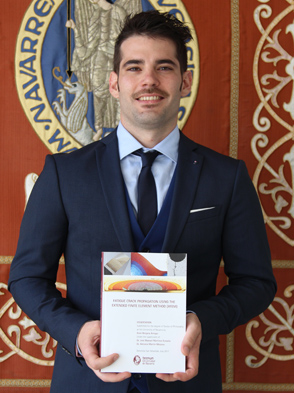PhD Thesis, Asier Bergara

Asier Bergara
Title: Fatigue Crack Propagation Using The Extended Finite Element Method (XFEM)
Defense Date: 26/07/2017
Director: José Manuel Martínez Esnaola
Abstract
Fatigue failure accounts for most of mechanical failures in engineering components during service life. Often the failure is sudden, without previous warning. Therefore, crack growth behaviour is a major issue in scheduling of maintenance and inspection of a variety of industries. Aerospace engines and components are an obvious example, where failure could lead to catastrophic consequences and the loss of human lives.
Traditionally, crack growth behaviour has been evaluated by experimental tests. However, the use of just empirical methods is rather impractical and inefficient due to high costs and long-time testing. The Finite Element Method (FEM) is the most powerful and common numerical tool for fracture mechanics studies. However, the conventional FEM causes troubleshooting in geometric nonlinearities. The Extended Finite Element Method (XFEM) enlarges the application of the basic formulation to solve crack propagation problems. XFEM-based formulation offers the advantage of modelling discontinuities and singularities independently of the finite element mesh. This characteristic makes the XFEM very attractive to study crack propagation, since it is not necessary to update the mesh and crack can propagate in a solution-dependent path.
In this thesis, the capabilities and advantages of the XFEM for crack propagation analysis are investigated. Furthermore, the ease of crack modelling and crack propagation is studied. In order to validate such capabilities, different experimental tests have been designed and have been carried out. For the numerical simulations, the XFEM-based LEFM approach implemented in the Abaqus® 2017 software has been used. The comparison between experimental tests and numerical simulations regarding the number of cycles to failure and crack shape geometry during crack growth is presented. In addition, sensitivity analyses of the numerical models are performed.